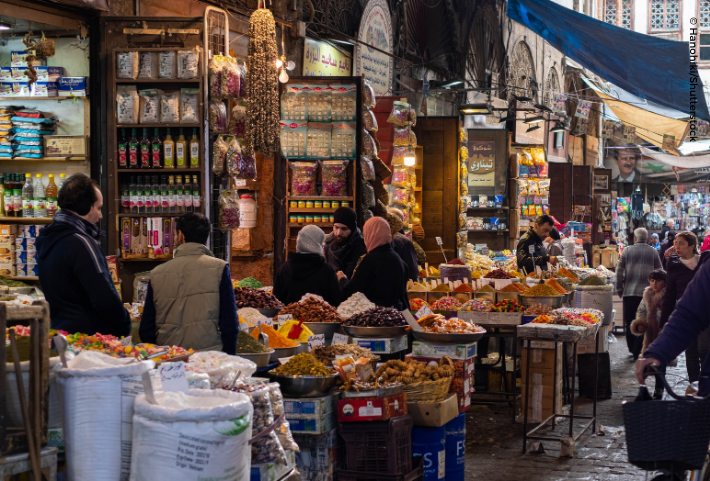By Natacha Danon, Programs Manager at Syria Direct
DAMASCUS—In the Syrian capital, run down yellow taxis rumble around the city emitting plumes of black smoke. Most of the oil is processed by hand in informal refineries, then smuggled across control lines from the Kurdish-controlled northeast—or from neighbouring Lebanon. The absence of quality, affordable fuel has led to periodic shortages and driven up the prices of goods.
Following the Assad regime’s fall in December, taxi drivers converged on Damascus in search of work. For these taxi drivers—like their fellow citizens—the economy is the first thing on their lips when they speak to any foreigner. The culprit, they say, is foreign sanctions, like the United States’ Caesar sanctions. Passed in 2019, the Caesar Act targets economic sectors and financial institutions, as well as individuals affiliated with the regime.

They aren’t far from the truth. The Syrian economy has deteriorated under the weight of over a decade of sanctions—in addition to the predatory practices of the former government. The regime engaged in corruption on a massive scale, played with the foreign exchange rate, and pumped out currency, driving up inflation and causing the value of the Syrian pound to plummet.
Nearly three months after the armed opposition swept into Damascus, the sense of euphoria at the end of Bashar al-Assad’s reign is ebbing and Syrians are contending with a cold reality: a battered economy, crumbling state institutions and a fragmented civil society.
Post-regime reality
Since the former regime fell, the new government has cracked down on corruption and the US and Europe have provided some sanctions relief. However, the regime’s economic policies will take time to unravel, while foreign restrictions remain on the banking sector and private investment, sidelining any possibility of large-scale reconstruction. A 2022 World Bank assessment estimated damage and destruction across key cities to be $8.7-11.4 billion. In the meantime, the value of the Syrian pound against the dollar has continued to fluctuate on a daily basis, undermining consumers’ purchasing power and preventing businesses from being able to calculate their operating costs.
Foreign aid on a massive scale to rebuild the country has not been forthcoming. Instead, the US, the world’s single largest donor, has slashed aid. In 2024, the US accounted for a quarter—nearly $400 million—of humanitarian funding in Syria. While there are some exceptions for life-saving assistance, the impacts of the cuts are being felt across the country. Stabilisation and development programming have been particularly hard hit, meaning support for reconstruction is unlikely to come from the US. The United Kingdom recently followed suit with a 40 percent cut to its foreign aid budget.
In the absence of funding, basic services have continued to crumble and hundreds of thousands of jobs in the public sector have been slashed. In much of the country, public electricity is restricted to two hours per day. Much of the country’s basic infrastructure has not been repaired due to sanctions, while years of dependency on emergency assistance has left a parallel state in the form of non-governmental organisations (NGOs) without sustainability. Although sanctions do not directly target service sectors, they prevent them from importing much needed goods and equipment, leading to shortages or lower quality and costlier imports.
Meanwhile, the country is marked by deep divisions, with the Kurdish-controlled northeast and the Druze-controlled southeast out of the grasp of the armed opposition that now rules Damascus. The new president, Ahmed al-Sharaa, has been outspoken against any form of decentralisation, leading to a stalemate with these minority groups. Even within its own ranks, it has struggled to assert control. The Turkish-backed Syrian National Army (SNA) follows its own chain of command, separate from that of Hay’at Tahrir al-Sham (HTS) and other allied groups. Meanwhile, weapons have proliferated—as civilians and combatants alike seized weapons from stockpiles as the regime collapsed—challenging the new state’s monopoly on arms. In addition, the country’s territorial integrity has been threatened by an ongoing Israeli military campaign in the southwest that has seized large swathes of land.
Civil society also remains divided, as organisations compete for increasingly scarce foreign funding and tensions emerge between those that remained inside Syria and those that fled abroad. In addition, misinformation and disinformation—propagated largely by remnants of the Syrian regime and its backer Iran—have sowed fear and divisions along ethno-sectarian lines. In certain parts of the country, these fears have been confirmed as killings of civilians occur on a sectarian basis against Alawites, to which the Assad clan belonged. In other cases, revenge killings have taken place against members of the former regime across sectarian lines. Meanwhile, transitional justice remains out of reach, as accountability for the families of thousands of detainees killed in regime prisons remains under discussion.
Syrians have no delusions about the path ahead, but many are prepared to take to the streets once again if the new government in Damascus fails to deliver on its promises or resorts to practices employed by the former regime. While the new government has proclaimed the end of the revolution, it remains very much alive.
The views and opinions expressed in this article are solely those of the author and do not reflect the official policy or position of the Media Diversity Institute. Any question or comment should be addressed to [email protected]
